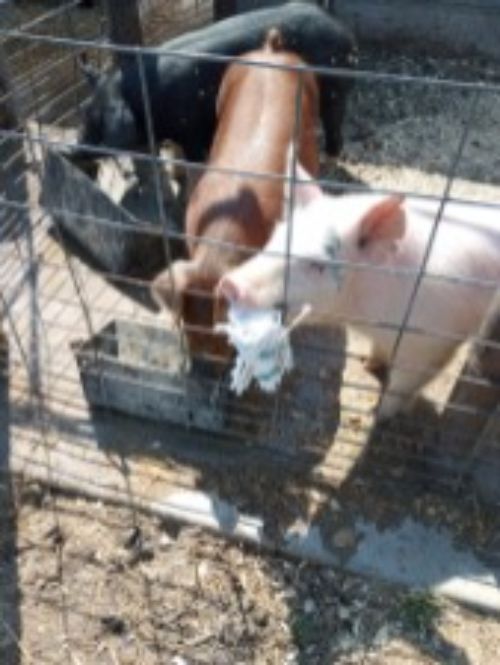Insights into small swine producers: Survey results on health, management and sustainability
An overview into the practices, challenges and needs of independent swine producers and independent swine herd veterinarians from a 2024 National Pork Board funded survey.

The swine industry is evolving, and with an increase in the farm-to-table movement, family swine farms are becoming more prevalent as large-scale producers hold a major impact on imports and exports from the United States. However, with more first-generation farmers coming into the livestock sector, less on-farm knowledge and experience is a major concern.
According to a survey conducted in 2024 that reached over 200 U.S. swine producers and 20 small swine herd veterinarians, 26% of swine producers focus on raising pigs for commercial markets, while 23% focus on freezer meat and direct sales. Smaller-scale operations were the target contributors of the survey, with 9% of swine producers surveyed managing fewer than 100 pigs and 17% managing between 251 and 999 pigs.
Swine herd health is a top priority for producers and veterinarians, with respiratory issues being the most significant concern for 48% of producers and 72% of veterinarians. Reproductive issues and scours (diarrhea) are notable concerns, affecting 40% of producers and 61% of veterinarians. Vaccination plays a critical role in addressing these challenges, with 66% of producers using and 78% of veterinarians recommending vaccines to prevent diseases like circovirus (PCV2), which is targeted by 74% of producers.
Producer Survey Question: If you are using a vaccination program for your herd, what are more likely to use for your herd?
- Circovirus (PCV2), 74%
- Leptospirosis, Erysipelas, Parvo (PLE), 73%
- Mycoplasma Hypopneumoniea, 70%
- PRRSv, 52%
- E. Coli, 38%
- Ileitis, 36%
- Swine Influenza, 32%
- Clostridium, 23%
- Rotavirus or Coronavirus, 22%
Veterinarian Survey Question: What vaccination do you typically recommend and/or prescribe to your producers?
- Circovirus (PCV2), 93%
- Mycoplasma Hypopneumoniea, 79%
- Leptospirosis, Erysipelas, Parvo (PLE), 79%
- Swine Influenza, 64%
- Clostridium, 50%
- PRRSv, 43%
- Ileitis, 43%
- E. Coli, 36%
- Rotavirus or Coronavirus, 7%
Regarding antibiotic use within swine farms, 67% of producers reported using antibiotics in the last year, with 46% using both in-feed and injectable antibiotics. The other third of reported producers who did not report using antibiotics suggest they do not treat their herds or are using alternative management strategies. At the same time, the primary therapy of antibiotics is still the first choice among producers for ill pigs.
Biosecurity practices are another central area of focus within the swine industry, as 75% of producers and 78% of veterinarians implement biosecurity measures to prevent the spread of disease, such as cleaning and disinfecting equipment and pens to shower or change clothes around their herd. Both producers (62%) and veterinarians (44%) reported concerns about managing disease outbreaks such as Porcine Reproductive and Respiratory Syndrome virus (PRRSv), Leptospirosis, and Circovirus.
The survey responses highlight the importance of biosecurity and disease management as foundational practices to protect herds. Feeding practices also affect a swine herd's overall health and growth, with 55% of the producers using purchased complete feed and only a third of them mixing rations for their herd. Pigs need a balanced and nutritious diet to promote growth, health, and reproductive performance.
Both producers and veterinarians indicated educational needs in their responses to the survey. Education emerged as a recurring theme in the survey results, with 42% of producers expressing a need for more knowledge in nutrition, 39% in health, and 41% in marketing. These areas underscore the necessity for improved farm management through better feeding practices, disease prevention strategies, and effective pork product marketing. Similarly, veterinarians also voiced a need for more training, with 4% seeking education in health and 39% in environmental management. The responses also stressed the importance of more client-focused education, with nutrition, health, and biosecurity being top needs for swine producers across the United States.
Producer survey question: What education or knowledge about pig production would you like to know? (Select all that apply)
- Nutrition, 42%
- Marketing, 41%
- Health, 39%
- Reproduction, 33%
- Genetics, 28%
- Housing/Pastures, 21%
- Environmental (manure handling, soil and water management), 20%
- Biosecurity, 18%
- Home Processing, 18%
Veterinarian survey question: What education or knowledge about pig production would you like to have? (Select all that apply)
- Health, 44%
- Environmental (manure handling, soil and water management), 39%
- Nutrition, 33%
- Housing/Pastures, 33%
- Reproduction, 28%
- Genetics, 22%
- Biosecurity, 17%
- Marketing, 17%
- Home Processing, 17%
Veterinarian survey question: What education or knowledge about pig production do you believe your swine clients need? (Select all the apply)
- Nutrition, 67%
- Health, 61%
- Biosecurity, 50%
- Housing/Pastures, 44%
- Reproduction, 44%
- Environmental (manure handling, soil and water management), 39%
- Genetics, 33%
- Marketing, 11%
- Home Processing, 5%
The survey identifies areas for improvement and exemplifies the potential for significant progress across multiple areas, including health management, nutrition, biosecurity, and education. Based on the survey, swine experts can work closely with producers and veterinarians to help ensure long-term success and sustainability of the industry. By promoting collaboration, continuous learning, and best practices, we can tackle the challenges of both small and larger-scale operations face. This approach will lead to healthier herds, more efficient farm management and a stronger, more sustainable swine industry.



 Print
Print Email
Email



